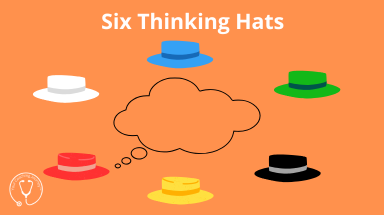Prefer to listen?
This blog post forms the basis of a podcast in which you can also listen to Helen taking your through a short mindfulness practice to help you ‘arrive’, which could be used with coachees at the start of a session. Listen in here.
What Are The Six Thinking Hats?
This model may not be appropriate for every coaching session, but it is quite a good way of helping the coachee to look at a situation from different perspectives. It is the creation of Edward De Bono, a Maltese Physician and academic who studied medicine in Malta, and then in both Oxford and Cambridge. He is probably best known for being the creator of a concept called lateral thinking and parallel thinking. The six thinking hats is an example of parallel thinking, because you’re thinking about a situation from different perspectives in parallel.
What are the six thinking hats?
The six thinking hats are the components of the model that Edward De Bono came up with to think through problems, desired outcomes, and projects in around 1985.
The model was designed to help individuals and teams look at problems and situations from multiple angles and really was to help foster creativity, balanced decision making, and better communication. All of which are quite useful in the coaching room. It was trying to get away from it being an adversarial process. The metaphorical hats are the representation of different ways of thinking and inviting people to wear a different hat to think through the situation allows for a bit of fun and a bit of creativity.
What modes of thinking do the six hats represent?

Blue Hat
This is our starting hat. It is the managing hat, the coordinator’s hat, the facilitator’s hat. Whoever’s managing the process of thinking is going to wear the blue hat. As a coach, you might decide that you are going to be wearing, wearing the blue hat for a thinking hat session, so you’re facilitating the process. At some point we might want to take the blue hat off and give it to the coachee for them to take over managing the process and for them to think for themselves in terms of the process. But to start with if we wear the blue hat, that’s going to be the most practical. If you were working as a team, if you were holding a six thinking hat session with your team, again, the facilitator would wear the blue hat and would manage the time for everyone to have their say and when they should switch hats. If you were working with a team, then everyone could explore one hat at a time, or maybe everyone has a different hat, it’s very adaptable.
Often within teams there’ll be one person in the room who has that approach of critical analysis. They’re the one that always seems to be picking fault. Someone will think they’ve come up with a fantastic idea and then someone else in the room will say, ‘but have you thought about this? Because this isn’t going to work’. And all the energy drains out of the room. You do need that person, but if it’s the same person every time, they get a bit of a reputation for being negative. If you can see the detail and you’re in a room full of people who don’t see the detail, of course you’re going to be seen as negative. You might, therefore, in a meeting about a new idea, invite everyone else to wear the black hat before the ‘detail person’ gets to have their say, so they’re not the only one. We’ll come on to the black hat shortly.

White Hat
This focuses on the facts, the data, and the information. It’s the information gathering piece. If you’re working in a team and everyone’s got the white hat on, they’re all coming up with everything they know about what’s happening and what data they have. It might also include exploring data gaps and what further data you need.

Red Hat
This is which is how you feel about the situation. The emotions, the gut feeling, It’s really important in the coaching room to explore people’s emotions and to get out what their take on it is. If there is some gut feeling, what that is, without any judgment, and knowing that whatever emotions come up, it’s ok.
Quite often in the coaching room when you ask people what emotions are coming up for them, they’ll talk about how they think about it, and they don’t actually go in to that emotional place, so that takes a little bit of probing but it’s worth the effort to really get to understand what emotions are going on for people.

Black Hat.
As alluded to earlier, that is the critical hat. Whilst we’re wearing that, we are going to come up with possible problems that might emerge. Also, what barriers are we going to run into? What problems do we foresee, what we might be overlooking because we’re particularly excited. The black hat allows us the time and space to come up with anything that might get in the way of us doing what we want to do.

Yellow Hat
This is the opposite of the black hat., it’s the optimism. What are the possible benefits of doing this? What’s the value to it? Taken in isolation, the yellow hat could be just seen as that kind of Pollyanna approach that nothing could possibly go wrong, getting carried away with the new idea. But in balance with the other hats, it’s useful to see what, what would be the benefits.

Green Hat
This is the creative hat, thinking of all the possibilities that are connected with the project, how it might be taken forward. Brainstorming ideas, thinking outside the box, all of that sort of stuff that people get involved in when they’re thinking about how things might turn out. Coming up with new thinking, which again, is very much what we’re looking for in the coaching room.
Thinking about the coaching room, how does this tool apply to transformational coaching?
It is a fantastic way of getting people to shift their perspectives. If someone is very positive about something, just saying to them, ‘okay, let’s just for a moment, take that yellow hat / positive outlook off and let’s put the black hat/critical analysis on for a moment. Just sit there with the black hat on for a moment and tell me what could possibly go wrong with this?’
You could offer that invitation without you being seen as the negative person. It’s normalising looking at a situation from different perspectives and having six different perspectives to look at it from.
How could you integrate this into a coaching session?
Simply ask them what knowledge they have of the six thinking hats, then you could explain it to them, if they don’t know how it works. Then offer that invitation to work through their dilemma using those six hats, talking it through and then reflecting on what they’ve learned from each hat at the end of the session. For example,
‘Now you’ve heard from all the different hats, what are you taking away from it?’
It’s almost a perfect model for a coaching conversation and can be slotted it into TOMS CODE easily as well.
In Summary
Edward de Bono’s Six Thinking hats is definitely something that you could introduce into your coaching and to bring a refreshing structure to the coaching, to look at things from different perspectives. Our trained coaches are used to using things like the empty chair exercise, for example, in order to think about looking at a situation through other people’s eyes, but this allows you to explore the different views you have on a project and actually segment them and take them out, give them an airing, and then move on to something else, rather than jumping backwards and forwards. Our invitation is therefore extended to you to try it out, where appropriate and see how useful you and your coachees find it.
To find out more about our Doctors’ Transformational Coaching Diploma click through here



